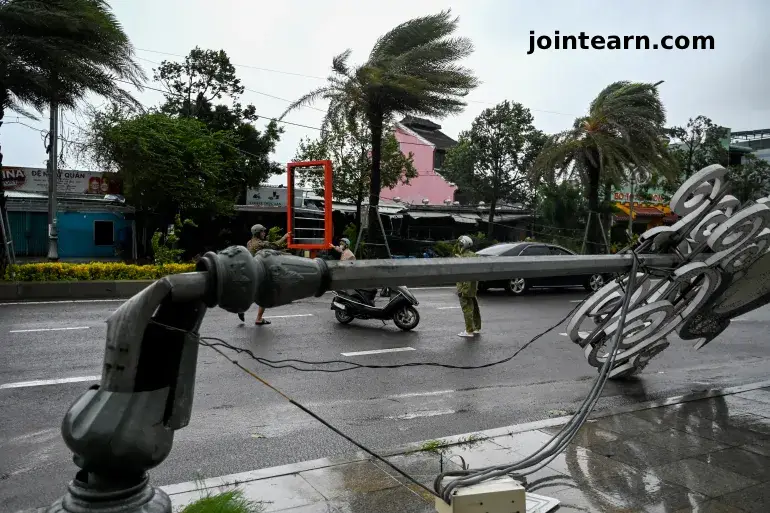
Typhoon Kalmaegi has struck central Vietnam with ferocious winds and torrential rain after leaving a trail of destruction in the Philippines, where at least 142 people were killed and hundreds remain missing. The deadly storm is now threatening Vietnam’s central regions, raising concerns over floods, landslides, and widespread damage to homes and infrastructure.
Kalmaegi Hits Vietnam’s Central Provinces
Kalmaegi made landfall late Thursday in Gia Lai province, one of Vietnam’s central highlands, carrying sustained winds of up to 149 km/h (92.5 mph), with gusts reaching even higher, according to the Ministry of Natural Resources and Environment.
Residents reported severe damage to homes and public infrastructure. “The wind is so strong, nothing can resist,” said Vu Van Hao, 48, surveying broken windows in a hotel lobby near Quy Nhon Beach. Meteorologists warn that waves as high as 10 meters (33 feet) battered the central coast as the typhoon approached.
Vietnamese authorities have mobilized more than 268,000 soldiers for search and rescue operations and issued warnings for floods in low-lying areas. Schools in Gia Lai and Quang Ngai provinces were closed, and six airports suspended operations, canceling hundreds of flights.
Devastation in the Philippines
Before hitting Vietnam, Kalmaegi—known locally in the Philippines as Typhoon Tino—caused catastrophic damage across eight central provinces. The storm killed at least 142 people and left 127 others missing, prompting President Ferdinand Marcos Jr. to declare a state of emergency.
In Cebu province, one of the hardest-hit areas, over 200,000 residents evacuated before the storm, many of whom have returned to find their homes destroyed, vehicles overturned, and streets blocked with debris. Cleanup operations are ongoing, with officials prioritizing debris removal to aid relief efforts and locate missing persons.
“This is a huge typhoon with terrible devastating capacity,” said Pham Anh Tuan, a senior official in Gia Lai, describing the storm’s impact on communities.
Vietnam Prepares for the Worst
Vietnam is no stranger to tropical cyclones, typically experiencing 10 typhoons per year, but Kalmaegi is the 13th storm of 2025, making it unusually intense. The Central Highlands, the country’s main coffee-growing region, faces potential damage to agriculture, while low-lying areas risk flooding and landslides.
The region is still recovering from October’s severe flooding, which caused over 150 landslides, submerged 2,200 hectares (5,400 acres) of crops, and inundated more than 103,000 houses. Authorities are urging residents to evacuate promptly to minimize casualties.
Another Super Typhoon Threatens the Philippines
Adding to the concern, the Philippine Atmospheric, Geophysical, and Astronomical Services Administration (PAGASA) warned that Typhoon Fung-wong (locally known as Uwan) could intensify into a super typhoon by Saturday, threatening northern and central Luzon, including Manila. President Marcos cautioned that this incoming storm could be even stronger than Kalmaegi, emphasizing the need for immediate preparation and emergency response measures.
Humanitarian Response and Recovery Efforts
Across both countries, emergency services are focused on rescuing trapped residents, clearing debris, and restoring essential services. In the Philippines, the government has prioritized relief distribution, emergency funding, and food security, while in Vietnam, authorities are evacuating hundreds of thousands of people and coordinating military and civil defense operations.
Typhoon Kalmaegi is a stark reminder of the vulnerability of Southeast Asian nations to intense tropical cyclones and the importance of disaster preparedness, early warning systems, and community resilience in mitigating human and economic losses.


Leave a Reply